
Dr. John Michael, Sheren Jasim
Assyrian Academic Society
Historical Background
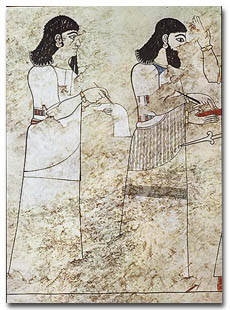 The Assyrians are the indigenous people of
Mesopotamia and have a history spanning over 6700 years. Moreover, they are the
descendants of the ancient Assyrians- builders of the earliest civilization. Although the
Assyrian empire ended in 612 B.C., history is replete with recorded details of the
continuous persistence of the Assyrian people till the present time. Assyrian civilization
at one time incorporated the entire Near East, most notably the area of the Fertile
Crescent. The heartland (Northern Mesopotamia) of Assyria lies in present-day northern
Iraq, southeastern Turkey, northeastern Syria, and northwestern Iran. The remains of the
ancient capital of Assyria, Nineveh, lie within Mosul in northern Iraq.
The Assyrians are the indigenous people of
Mesopotamia and have a history spanning over 6700 years. Moreover, they are the
descendants of the ancient Assyrians- builders of the earliest civilization. Although the
Assyrian empire ended in 612 B.C., history is replete with recorded details of the
continuous persistence of the Assyrian people till the present time. Assyrian civilization
at one time incorporated the entire Near East, most notably the area of the Fertile
Crescent. The heartland (Northern Mesopotamia) of Assyria lies in present-day northern
Iraq, southeastern Turkey, northeastern Syria, and northwestern Iran. The remains of the
ancient capital of Assyria, Nineveh, lie within Mosul in northern Iraq.
The worlds 3.5 million Assyrians are currently dispersed with members of the diaspora comprising nearly one-third of the population. The remaining Assyrians reside primarily in Iraq, Syria, Lebanon, Iran, and Turkey. Most of the Assyrians in the diaspora live in North America, Europe, and Australia. In the U.S., the
Assyrians have very successfully assimilated with the vast majority pursuing higher learning. Assyrians-Americans have also been quite patriotic, such that many have honorably served in the armed forces while others have sought and held public office.
The probable time frame in which the first Assyrians came to Chicago initially as seminarians and later as medical students would be between the 1880's and 1890's. Eventually, by the turn of the century some Assyrians began to reside in Chicago. In 1909, 30 Assyrian families and 600 Assyrian young men permanently lived in Chicago. Many worked as carpenters, masons, painters, and tailors while others worked in factories, hotels, and restaurants.
 Between 1915-1918 during World War I, Turkish and Kurdish forces
massacred 750,000 Assyrians. The survivors of this Assyrian holocaust were scattered
throughout the Middle East, Europe and North America. Consequently, by the middle 1920's,
the community in Chicago had increased to over 3000. The greatest concentration of these
new arrivals settled around Clark and Huron. Most of these immigrants came from villages
in northwestern Iran (Lake Urmia) and southeastern Turkey (Hakkari mountains).
Between 1915-1918 during World War I, Turkish and Kurdish forces
massacred 750,000 Assyrians. The survivors of this Assyrian holocaust were scattered
throughout the Middle East, Europe and North America. Consequently, by the middle 1920's,
the community in Chicago had increased to over 3000. The greatest concentration of these
new arrivals settled around Clark and Huron. Most of these immigrants came from villages
in northwestern Iran (Lake Urmia) and southeastern Turkey (Hakkari mountains).
By the 1930's, the Assyrian community slowly moved northward towards Lincoln Park, Lakeview, and Uptown. A steady stream of new arrivals from Iran, Iraq, and Syria continued through World War II. One survey estimated 5,000 Assyrians in Chicago in 1944. Chicago's Assyrian population was three times as great as any other American city. An August 12, 1940 Time magazine article on the arrival of the Assyrian Patriarch Mar Eshai Shimun to the U.S. estimated the Assyrian population in the U.S. at 70,000 although this number was not stratified regionally.
Following another wave of persecution in Iran in 1948, more Assyrians arrived in the U.S. from Iran. In the 1960's, larger numbers entered from Iraqi cities such as Baghdad, Kirkuk, and Basra. During the Lebanese War of 1975-1992, many Assyrians immigrated to the Chicago area.
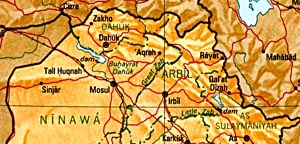 In the 1980's and 90's, larger numbers of Assyrians came to
Chicago on account of the Iran-Iraq war. The suffering following Gulf War in 1991 and the
subsequent U.N. embargo against Iraq has led to still more refugees fleeing shortages of
food and medicine. Many Assyrians continue to arrive from Iraq, Iran, Syria, Lebanon, and
Turkey as students or as family reunification immigrants.
In the 1980's and 90's, larger numbers of Assyrians came to
Chicago on account of the Iran-Iraq war. The suffering following Gulf War in 1991 and the
subsequent U.N. embargo against Iraq has led to still more refugees fleeing shortages of
food and medicine. Many Assyrians continue to arrive from Iraq, Iran, Syria, Lebanon, and
Turkey as students or as family reunification immigrants.
Relatives and several private Assyrian social-welfare organizations as well as the various churches have supported most of these Assyrian refugees. Catholic Charities and the Church World Service have assisted some Assyrians.
Demographics

Most Assyrians in Chicago live on the north side of the city. The greatest number resides in West Rogers Park. Smaller concentrations live in Edgewater, Andersonville, Budlong Woods, Ravenswood, Hollywood Park, Peterson Park, East Rogers Park, and Albany Park. Many Assyrians have begun to move into the near north and northwest suburbs such as Skokie, Morton Grove, Niles, Des Plaines, Itasca, Schaumburg, and Arlington Heights. A sizeable community also resides in Elgin.
There is no reliable official census estimate of Assyrians in the U.S. because they come from various different countries. It is believed that the vast majority of Assyrian immigrants are classified as citizens of their respective countries of origin. Thus, an Assyrian from Syria may be classified as Syrian while one from Iran Iranian, etc. Consequently, only a small portion is classified as Assyrian by the official census. According to the official U.S. Census, the following designations are entailed under the Assyrian identity: Aramean, Assyrian, Chaldean, Chaldo, Jacobite, Kaldany, Kaldu, Kasddem, Kasdu, Nestorian, and Telkefe.
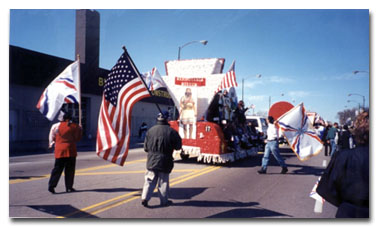 Estimations indicate roughly half of the newly arrived Assyrian
immigrants are employed, 1/4 are homemakers, 1/10 are retired, and 1/10 are unemployed.
Culturally speaking, Assyrians place a great emphasis on educational opportunity. As a
result, the majority of Assyrians raised in the U.S. is college educated; still more, a
growing number are pursuing higher graduate education in medicine, law, computer science,
education, and the sciences. Many other Assyrians work in clerical positions, insurance
companies, real estate, building maintenance, and hotels. Some Assyrians work in unskilled
or semiskilled capacities such as factories and as taxi drivers.
Estimations indicate roughly half of the newly arrived Assyrian
immigrants are employed, 1/4 are homemakers, 1/10 are retired, and 1/10 are unemployed.
Culturally speaking, Assyrians place a great emphasis on educational opportunity. As a
result, the majority of Assyrians raised in the U.S. is college educated; still more, a
growing number are pursuing higher graduate education in medicine, law, computer science,
education, and the sciences. Many other Assyrians work in clerical positions, insurance
companies, real estate, building maintenance, and hotels. Some Assyrians work in unskilled
or semiskilled capacities such as factories and as taxi drivers.
Statistics regarding unemployment are misleading since many skilled or highly educated Assyrians fleeing war-torn countries need to spend years certifying their previous education or experience while others are forced to begin their education anew. Familiar anecdotal stories include the university professor from Iraq working as an unskilled assembly line employee while waiting to rectify in U.S. institutions of higher learning. Also, within the ranks of the unemployed one may find a residency-trained physician awaiting completion of a series of board examinations and applications to U.S. residency programs.
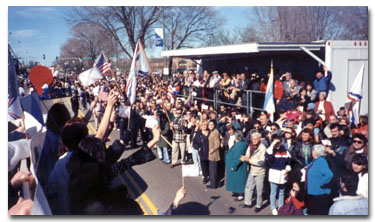 The Assyrians are industrious and have a great entrepreneurial
spirit. Many Assyrians are small business owners. A review of the Assyrian Business and
Professional Directory for 1996-97 showed 390 entries in the Chicago land area. These
estimates are believed to be low since not all businesses have been included. Some
estimates suggest the numbers may be twice as high. The most common types of Assyrian
businesses include video rental stores (estimates range between 43- 150), restaurants, gas
stations, auto repair shops, convenience stores, auto dealerships, beauty salons, computer
stores, alteration shops, air conditioning and heating, photography, insurance, real
estate, and construction contractors. Scores of physicians, dentists, lawyers and
accountants are also found in the Assyrian Business and Professional Directory. There are
at least two anodizing plants, three manufacturing plants, and two major parking lot
chains.
The Assyrians are industrious and have a great entrepreneurial
spirit. Many Assyrians are small business owners. A review of the Assyrian Business and
Professional Directory for 1996-97 showed 390 entries in the Chicago land area. These
estimates are believed to be low since not all businesses have been included. Some
estimates suggest the numbers may be twice as high. The most common types of Assyrian
businesses include video rental stores (estimates range between 43- 150), restaurants, gas
stations, auto repair shops, convenience stores, auto dealerships, beauty salons, computer
stores, alteration shops, air conditioning and heating, photography, insurance, real
estate, and construction contractors. Scores of physicians, dentists, lawyers and
accountants are also found in the Assyrian Business and Professional Directory. There are
at least two anodizing plants, three manufacturing plants, and two major parking lot
chains.
Most Assyrians that arrived in Chicago during the 1970's came from Iraq. With the exception of the elderly, estimates suggest that 80-85 % of younger Assyrians coming from Iraq are college educated without a gender-based difference. As most of the institutions of higher learning in the Middle East are based on English as a second language, most Assyrian immigrants received some or most of their education in English. Few elderly Assyrians including those who directly survived the holocaust of 1915 and their direct descendants received no formal education since they were dislodged from their homes and forced into refugee camps. Of those Assyrians raised in the U.S., the vast majority complete high school and a large growing majority are entering college or trade schools.
The intermarriage rate for Assyrians arriving since the 1970's is quite low with some estimates suggesting less than 10%. Of those Assyrians arriving before World War II when the community in Chicago was still relatively small, the intermarriage rate is higher. Even with intermarriage, though, close links to the community are preserved.

Current Migration Patterns
Many Assyrians are continuing to move into the near north suburbs of Chicago, although the majority still reside in Chicago. The current of trend relocating to the west coast (primarily Phoenix, AZ) seems to be surfacing among Assyrian families. Assyrians still choose to move into communities where other Assyrians already reside. Although economic and political conditions in their countries of origin (e.g. Iraq) are precarious, many still return to visit relatives in Iran, Iraq, Lebanon, Syria, and Turkey. A few Assyrians have returned to live in their original countries.
Language
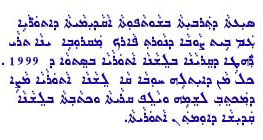 Assyrians in Chicago speak modern Assyrian, which is also called
Syriac (Surit) or Aramaic and has its own unique alphabet. It is a derivative of Ancient
Assyrian (Akkadian and Aramaic). One of the greatest contributions the Assyrians have made
to civilization is the first writing system and alphabet. As a Semitic language, Assyrian
is related to Hebrew and Arabic but is distinct from and predates both. According to the
official U.S. Census of Population and Housing (1991), the following designations are
entailed under Syriac: Aramaic, Assyrian, and Chaldean.
Assyrians in Chicago speak modern Assyrian, which is also called
Syriac (Surit) or Aramaic and has its own unique alphabet. It is a derivative of Ancient
Assyrian (Akkadian and Aramaic). One of the greatest contributions the Assyrians have made
to civilization is the first writing system and alphabet. As a Semitic language, Assyrian
is related to Hebrew and Arabic but is distinct from and predates both. According to the
official U.S. Census of Population and Housing (1991), the following designations are
entailed under Syriac: Aramaic, Assyrian, and Chaldean.
Due to persecution, dispersion and forced assimilation in their native countries, many immigrant Assyrians cannot read and write the Assyrian language. However, with a reawakened nationalist awareness, many Assyrians in the Chicago diaspora are learning the language in Churches and various organizations such as the Assyrian Academic Society and the Mar Zaia Assyrian Organization. In addition, Assyrian children are strongly encouraged to speak Assyrian in the vast majority of Assyrian homes.
Most Assyrian immigrants speak the language of their native country such as Arabic, Persian, or Turkish and as such, along with English and Assyrian, are functionally trilingual. Some Assyrians educated in Lebanon or Syria under the French educational system are fluent in Assyrian, Arabic, French, and English.
Religion
The Assyrians were the first to accept Christianity in the first century A.D. through Mar Addai (the Apostle Thadeus and his disciple Mari). Despite the subsequent Islamic conquest of the region, the Assyrian Church flourished and its adherents at one time numbered in the millions. Assyrian missionary zeal was unmatched and led to the first Christian missions to China, Japan, and the Philippines. Early on, the Church consisted of two ancient branches, the Church of the East and the Syrian Orthodox Church.
Over time, divisions within these Churches led to other branches including the Chaldean Church, Syrian Catholic Church, Maronite Church (which are all Uniate Rites of the Roman Catholic Church) and the Jacobite Church. With persistent Western missionary pressure, especially within the past century, numerous Protestant Churches subsequently arose as well.
 Today, the Assyrians in general and in Chicago in particular
belong to three main Christian sects: the Church of the East, the Chaldean Church, and the
Syrian Orthodox Church. The Church of the East has three churches in Chicago (Mar
Gewargis, Mar Sargis, and St. John) and one in Bartlett (St. Mary's). The Chaldean Church has
two churches in Chicago (Mart Maryam and St. Ephraim). The Syrian
Orthodox Church has one Church in Villa Park (St. John the Baptist). Another recent branch
of the Church of the East was formed in resistance to certain reforms. This Ancient Church
of the East has an active church in Chicago (Mar Odisho).
Today, the Assyrians in general and in Chicago in particular
belong to three main Christian sects: the Church of the East, the Chaldean Church, and the
Syrian Orthodox Church. The Church of the East has three churches in Chicago (Mar
Gewargis, Mar Sargis, and St. John) and one in Bartlett (St. Mary's). The Chaldean Church has
two churches in Chicago (Mart Maryam and St. Ephraim). The Syrian
Orthodox Church has one Church in Villa Park (St. John the Baptist). Another recent branch
of the Church of the East was formed in resistance to certain reforms. This Ancient Church
of the East has an active church in Chicago (Mar Odisho).
The various Protestant branches in Chicago include the Assyrian Evangelical Church, the Assyrian Evangelical Covenant Church, the Assyrian Pentecostal Church, and the Carter Westminister Presbyterian.
Important Traditions
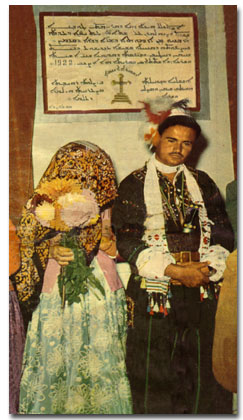 The Assyrian identity and awareness entails an inextricably
intertwined combination of language, culture, religion, and ethnic heritage. Various
cultural life-cycle traditions within the community are passed on from generation to
generation and in many ways reflect this awareness.
The Assyrian identity and awareness entails an inextricably
intertwined combination of language, culture, religion, and ethnic heritage. Various
cultural life-cycle traditions within the community are passed on from generation to
generation and in many ways reflect this awareness.
Regardless of Church adherence, most Assyrians commonly celebrate several distinctive life cycles such as baptism (Mamaduta), engagement (Talibuta or Shirinlikh) and weddings (Khloola). Mourning over death is very passionately expressed, as is a prolonged period of grieving. Several days of visitation to the residence of the deceased or their immediate relatives follow funerals. Mourners gather at the funeral to express the sorrow of the grieving family. Funeral visitation, called Basamta d'Risha, literally means "healing the head" and reflects a collective communal expression of respect for the deceased as well as comfort and support for the bereaved remaining relatives. Symbolic of Christ's resurrection, three days following the burial, friends and family revisit the grave. Further commemorations are shared in the community on the seventh and fortieth days, as well as one year after death. Also, immediate relatives of the deceased observe a one year period of abstinence from celebrations such as formal engagements and weddings.
Like many Middle Eastern communities, Assyrians are quite gregarious and place great emphasis on hospitality towards Assyrian and non-Assyrian visitors.
Holidays and Special Events
The Assyrian New Year is celebrated on April 1st, Kha B'Nissan. An annual parade down King Sargon Blvd (Western Avenue) between Peterson and Pratt has been organized over the previous several years. As of April 1, 1997, the Assyrian Calendar will read 6747.
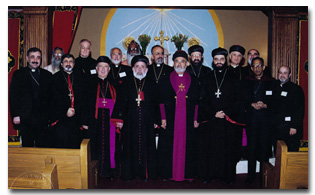 As Christians, Assyrians celebrate the major Christian holidays
of Easter and Christmas. Easter is seen as the theologically most important holiday as it
commemorates the resurrection of Jesus Christ. Consequently, it is called Eida Gura or big
holiday. Christmas, commemorating the birth of Christ, is called Eida Sura or small
holiday. Lent is observed with abstaining from meat and dairy products. Good Friday is
commemorated as Ruta D'khisha (Friday of mourning). Palm Sunday (Oshana) is also
commemorated when Jesus Christ entered Jerusalem the week prior to his crucifixion.
As Christians, Assyrians celebrate the major Christian holidays
of Easter and Christmas. Easter is seen as the theologically most important holiday as it
commemorates the resurrection of Jesus Christ. Consequently, it is called Eida Gura or big
holiday. Christmas, commemorating the birth of Christ, is called Eida Sura or small
holiday. Lent is observed with abstaining from meat and dairy products. Good Friday is
commemorated as Ruta D'khisha (Friday of mourning). Palm Sunday (Oshana) is also
commemorated when Jesus Christ entered Jerusalem the week prior to his crucifixion.
The prophet Jonah's mission to the people of Nineveh, the capital of Assyria, is celebrated by a three day fast, usually in February, and is known as the Rogation of the Ninevites (Ba'oota d'Ninwayeh).
Various Saints' Days are enthusiastically celebrated by many Assyrians. The Sharas are commemorations of anniversaries of saints; they can range from small family gatherings to large community picnics. A sacrificial lamb is prepared in commemoration of the saint. The sacrificial meal or Ddukhrana is distributed to all present. The most commonly commemorated saints include Mart Maryum (St. Mary), Mar Gewargis (St. George), Mar Zaia, Mar Odisho, Mar Bishu, Mar Sliwa, Solten Madu, and Mar Pithyu.
 Nusardil is an Assyrian holiday that symbolizes the baptismal
water rite and is connected to the ancient Assyrian ritual commemorating the autumnal
equinox. On this day, Assyrians ritualistically throw water upon each other in celebration
of baptism. In 1997, Nusardil will be celebrated on July 6th.
Nusardil is an Assyrian holiday that symbolizes the baptismal
water rite and is connected to the ancient Assyrian ritual commemorating the autumnal
equinox. On this day, Assyrians ritualistically throw water upon each other in celebration
of baptism. In 1997, Nusardil will be celebrated on July 6th.
Kaloo Soolaka (ascension of the bride) is celebrated 40 days after Easter and commemorates the day Christ ascended to heaven. Young girls are adorned in bridal apparel and go from house to house collecting treats. The girls are symbolic representations of the House of God. The holiday is meant to celebrate the separation of the "bride" (church) from her Lord Jesus Christ when he departed for heaven.
Somikah is observed 25 days before Christmas (Eida Sura) and 50 days before Easter (Eida Gura). During this holiday individuals of all ages dress in costumes and go from home to home singing traditional songs and acting out mini plays for their observers. The purpose is to serve as a reminder to all that the religious fast is to begin the following day.
Assyrian history is noteworthy as much for the seemingly unending massacres and genocides against the Assyrian people as it is for the brilliant contributions to civilization. Assyrian Martyrs' Day (Shawwa b'Tabakh) is a special holiday that is commemorated on August 7th in remembrance of all Assyrians persecuted throughout history on account of their religion and heritage. Although August 7th, 1933 is the day when Assyrians were massacred in Simele, Iraq, Assyrians Martyrs Day remembers all massacres and genocides including that of 1915 when three-quarters of the Assyrian population was massacred by Ottoman Turks and Kurds along with 1.5 million Armenians.
Foods for Special Occasions
The Assyrian diet is primarily a Middle Eastern and Mediterranean diet. There are regional differences reflecting influences from the countries of origin of the various Assyrians. Typical dishes include kabob, rice dishes with various meat and vegetable stews (Shorwa); different forms of cracked wheat or rice shells stuffed with meat (Kuba); and lamb, poultry, and fish dishes. Dolma or Yiprakhe is prepared by stuffing grapevine leaves, zucchini, eggplant, tomatoes, bell peppers, and onions with ground or chopped meat, spices and vegetables.
For special, usually religious occasions, Harisa is prepared consisting of wheat cooked with lamb meat and butter. Girdu is also prepared for special occasions and consists of rice and yogurt topped with melted butter.
Other foods include, Kadeh and Kilecheh, Reesheh w'Aqleh, Jajiroon, Kashka, Niskeh, Boushala, Shargooma, Sarpidoe, Khweesa, Dikhwa, Martookha, Kipteh, Gurgur, Katleteh, Potato Chep, etc.
Dietary Restrictions
Besides the dietary restrictions of meat and/or dairy products during certain religious holidays, and Wednesdays and Fridays during the week throughout the year, there are no dietary restrictions on Assyrians.
Names
Many Assyrians use the names of ancient Assyrian kings, queens, gods, goddesses, and cities. For males, names such as Ashur, Sargon, Nimrod, Ashurbanipal, and Sankheeru are common. For females, names include Shamiram, Sharokin (also for males), Nineveh, Ashurina, Atur (also for males), and Ishtar. Some are named after early Christian Syriac saints such as Zaia, Hurmiz, Ephraim, and Narsai. Biblical names include Esho (Jesus), Maryum (Mary), Yousep (Joseph), Oraham (Abraham), and Yaqo (Jacob). Western names are not excluded, many Assyrians choose European and American names for their children.
As a result of Arabization and assimilation programs, in the past, Assyrians were given only a first name followed by the name of their grandfather as a last name in order to cease the perpetuation of the "Assyrian" family name. Thus, even now, many Assyrian families have last names that appear as first names such as George, Joseph, Michael, Benjamin, Daniel, Esho, Oraham, Yaqo, Nimrod, etc. Some Assyrians were given Arabic or Persian names depending on their country of origin. Not only did this discontinue the family name but replaced them with non-Assyrian names (thus, wiping out the Assyrian identity in this aspect).
Major Issues for the Community
Assyrians in the diaspora are primarily concerned with balancing preservation of their distinct Assyrian self-awareness (including language, culture, and religion), with assimilation into mainstream American life. Specifically, the community is concerned about supporting the enhancement of religious, cultural, and educational Assyrian institutions. A major goal of the community is the establishment of a comprehensive Assyrian language school.
With seemingly perennial conflagrations in the Middle East, the Assyrian diaspora are also concerned about the political, economic, and human rights welfare of relatives overseas. Assyrians in Chicago have mobilized fundraising efforts to support Assyrians in distress overseas.
The community gives religious unity (between all Assyrian churches). Efforts to unite all theological branches are zealously carried out.
Political and Civic Participation
The Assyrian community has become increasingly energized in their political participation. Since many have emigrated from countries where political participation is restricted and Assyrians are disenfranchised, in the U.S. Assyrians have actively taken advantage of the right to vote. In addition, numerous prominent Assyrian leaders have become involved in several different election campaigns. These leaders have mobilized the community on behalf of numerous candidates from both the Democratic and Republican parties. Mayoral, aldermanic, U.S. Representative and Senatorial, Illinois State gubernatorial candidates have enjoyed enthusiastic support from the Assyrian community.
Links to Homeland
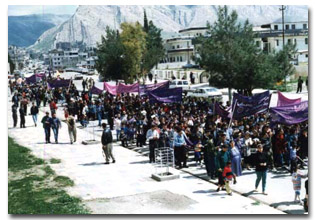 As a whole, the Assyrian community financially supports Assyrian
refugees in Jordan, Iraq, Turkey, Greece, Russia, and Georgia as well as other countries.
Officially registered charities such as the Assyrian Aid Society have raised funds for
food and medicine as well as the building of schools and rehabilitation of Assyrian
villages in northern Iraq. Other charities have launched a fundraising campaign for water
development projects in Syria. Individually, the vast majority of Assyrians with relatives
remaining overseas send assistance according to their financial ability.
As a whole, the Assyrian community financially supports Assyrian
refugees in Jordan, Iraq, Turkey, Greece, Russia, and Georgia as well as other countries.
Officially registered charities such as the Assyrian Aid Society have raised funds for
food and medicine as well as the building of schools and rehabilitation of Assyrian
villages in northern Iraq. Other charities have launched a fundraising campaign for water
development projects in Syria. Individually, the vast majority of Assyrians with relatives
remaining overseas send assistance according to their financial ability.
Numerous Assyrian journals and newspapers written in English, Assyrian, Arabic, or other languages such as Nabu Quarterly, Journal of the Assyrian Academic Society, The Assyrian Star, The Voice From the East, Nineveh, Huyodo, Bet-Nahrain, Zenda, Assyrian Quest, Assyrian Sentinal, Aghona, and The Assyrian Guardian among many others, maintain close links amongst the various Assyrian communities internationally. Aside from these publications there exist countless web pages, electronic journals and sites on the superhighway: Society.Culture.Assyrian (newsgroup), Assyria On-line (homepage), Nineveh On-line (homepage), Assyrian Academic Society (homepage), Mar Zaia Assyrian Organization (homepage), Assyrian School Action Committee (homepage), etc.
Unique Health Concerns
There is growing concern amongst Assyrian physicians caring for the Assyrian community regarding cigarette smoking in the community. Physicians counseling Assyrian patients often must contend with a fatalistic outlook that diminishes a patient’s will to quit smoking. In addition, occasionally poor control of hypertension, heart disease, and diabetes increases morbidity within the community. Moreover, education regarding regular screening for early detection of other illnesses, such as cancer, needs to target the Assyrian community.
Like many immigrant ethnic communities, language and cultural barriers may limit access to adequate health care for some elderly or more recently arrived Assyrians.
Myths and Misconceptions
Myth: The most common misconception is that Assyrians are Arabs or Syrians.
Fact: Assyrians are not Arabs, but rather have maintained a continuous and separate identity, language, and culture that predates the Arabization of the Middle East. Until today, the Assyrians speak a distinct modern Assyrian language, Syriac, the language spoken by Jesus Christ. As a Semitic language, the Assyrian language is related to Hebrew and Arabic but predates both. As a people, Assyrians share a history that predates that of any of their neighbors. In addition, whereas most Arabs are Muslim, Assyrians are by definition Christian. Assyrians also share a common history of collective persecution based on their religion, ethnicity, language, and culture. Although some Syrians are Assyrian, Assyrians on the whole are not to be confused with Syrians. Although the name Syria is directly derived from Assyria and the land was once a part of Assyria, most of the people of Syria currently officially maintain a separate Arab identity.
Myth: Assyrians are a religious minority in Iraq.
Fact: Assyrians are an ethnic minority, with a separate language, culture and heritage grounded in Christianity.
References
- The Assyrian Tragedy; Anonymous.
- Whither Christian Missions; David Perley.
- Iraq Since 1958: From Revolution to Dictatorship; Marion Sluglett.
- Tragedy of the Assyrians; R. S. Stafford.
- Our Smallest Ally; W. A. Wigram.
- The Might That Was Assyria; H.W.F. Saggs.
- History of Assyria; A.T. Olmstead.
- Hagarism: the Making of the Islamic World; Patricia Crone, Michael Cook.
- History of Christianity in Asia: Volume One, Beginnings to 1500; Samuel Moffet.
- Cambridge Ancient History: The Roman Republic, 133-44 B.C.; W. W. Tarn.
- By Foot to China: Mission of the Church of the East, to 1400; John M. L. Young.
- The Nestorians and their Rituals; George Percy Badger.
- A Short History of Syriac Christianity; W. Stewart McCullough.
- Patriarch, Shah, and Caliph; William G. Young.
- An Introduction to the History of the Assyrian Church; W. A. Wigram.
- The Church of the East and the Church of England; J. F. Coakley.
- Assyrian Church Customs and the Murder of Mar Shimun; Surma d'Bait Shimun
- The Assyrian Question; Joseph Yacoub.
- Genocides Against the Assyrian Nation: 612 B.C. to 1996 A.D.; David Malick, Peter Jasim.